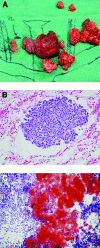Current understanding and management of medullary thyroid cancer
- PMID: 24037980
- PMCID: PMC3805151
- DOI: 10.1634/theoncologist.2013-0053
Current understanding and management of medullary thyroid cancer
Abstract
Medullary thyroid cancer (MTC) typically accounts for 3%-4% of all thyroid cancers. Although the majority of MTCs are sporadic, 20% of cases are hereditary. Hereditary MTC can be found in multiple endocrine neoplasia 2A or 2B or as part of familial MTC based on a specific germline mutation in the RET proto-oncogene. This article discusses the current approaches available for the diagnosis, evaluation, and management of patients and their family members with suspected MTC. The disease is predominantly managed surgically and typically requires a total thyroidectomy and lymph node dissection. A review of recent guidelines on the extent and timing of surgical excision is discussed. There are not very many effective systemic treatment options for MTC, but several emerging therapeutic targets have promise.
Keywords: Familial Medullary Thyroid Cancer (FMTC); Medullary Thyroid Cancer (MTC); Multiple Endocrine Neoplasia Syndrome; Prophylactic surgery in MTC; RET proto-oncogene; Serum calcitonin.
Conflict of interest statement
Disclosures of potential conflicts of interest may be found at the end of this article.
Figures

References
-
- Hundahl SA, Cady B, Cunningham MP, et al. Initial results from a prospective cohort study of 5583 cases of thyroid carcinoma treated in the united states during 1996. US and German Thyroid Cancer Study Group An American College of Surgeons Commission on Cancer Patient Care Evaluation study Cancer. 2000;89:202–217. - PubMed
-
- Thyroid Cancer Treatment (PDQ®) Medullary Thyroid Cancer. [Accessed July 29, 2013]. Available at http://www.cancer.gov/cancertopics/pdq/treatment/thyroid/HealthProfessio....
-
- Eng C, Clayton D, Schuffenecker I, et al. The relationship between specific RET proto-oncogene mutations and disease phenotype in multiple endocrine neoplasia type 2. International RET mutation consortium analysis. JAMA. 1996;276:1575–1579. - PubMed
-
- Mulligan LM, Eng C, Healey CS, et al. Specific mutations of the RET proto-oncogene are related to disease phenotype in MEN 2A and FMTC. Nat Genet. 1994;6:70–74. - PubMed
-
- Moline J, Eng C. Multiple endocrine neoplasia type 2: An overview. Genet Med. 2011;13:755–764. - PubMed
Publication types
MeSH terms
Substances
Supplementary concepts
LinkOut - more resources
Full Text Sources
Other Literature Sources
Medical

